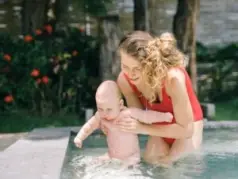
Drowning is a leading cause of death and severe injuries for children. More children between the ages 1 and 4 die from drowning that any other type of accident. Drowning is also the second highest cause of accidental deaths for children 14 and younger.
There are about 4000 fatal drowning deaths every year. Most childhood drownings happen in fresh water. A swimming is pool is the place where a child is most likely to drown, but a child can drown anywhere there is enough water.
The most important things you can do to protect children from drowning are getting them swimming lessons, installing secure locks and gates surrounding your pool, and making sure children are supervised when they are near a swimming pool or a body of water.
Where Do Drownings Occur?
Drowning is the process of respiratory impairment from submersion in liquid. It can happen in lakes, oceans, pools, and bathtubs. For infants, two thirds of drownings occur in bathtubs. For kids ages 1 to 4, most drownings happen in fresh water, especially in swimming pools.
The most common place for a swimming pool drowning to occur is at a private residence, but it can also happen at hotels, recreation centers, apartments, condominiums, and swim parks.
Children often drown when they are left unattended near a pool, when there is no lifeguard on duty, or when a pool doesn’t have an adequate fence or gate. But children can drown in pools even when a lifeguard is present.


Give us a call today to discover how we can assist you.
Fatal and Nonfatal Drowning
A fatal drowning is when death results form submersion in liquid, but most drownings are not fatal. For every child who dies from drowning, about eight children receive emergency care for a nonfatal drowning, an incident that does not result in death.
Non-fatal drownings that are treated in an emergency room often require further medical care such as hospitalization. These incidents frequently result in serious medical outcomes that may require long-term care, including:
- Coma
- Brain injuries
- Seizures
- Cognitive changes
- Personality changes
- Muscle weakness and paralysis (hemiparesis)
Preventing Drowning Accidents
One of the best ways to reduce the risk of drowning is make sure your child has formal swimming lessons. Never leave you children unattended around swimming pools or bodies of water. And all passengers on recreational boats must wear life preservers.
It’s essential to prevent for the following circumstances, which can all contribute to drowning:
- Pools without fences
- Pools without self-closing and self-latching gates
- Defective filters that allow dangerous suction
- Lack of supervision
- No lifejackets on boats
- No depth markers
- No warning signs
- Insufficient lighting
- No lifeguard on duty
- Lack of proper emergency equipment
- Distracted, unskilled, and untrained lifeguards
- Failure to create a prevention plan
- Failure to meet industry safety equipment standards
- Broken or missing emergency equipment
- Overcrowded swimming pools


We've offered crucial support and guidance to individuals who have suffered injuries, ensuring their financial and emotional well-being.
Was Your Child Harmed?
If your child was injured or killed due to an accident caused by someone’s careless behavior, we can help. Call DiBella Law Injury and Accident Lawyers at (978) 327-5140 to learn more today. We offer a free consultation.


We are committed to providing valuable information and resources to assist you.





